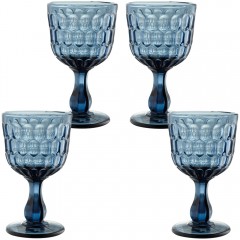The Metropolitan Museum of Arts collection includes a thumbprint goblet made about 1850–70 by Bakewell, Pears and Company of Pittsburgh (1836–1882). “Thumbprint” was an imitation of more expensive cut glass, with concave oval facets that create a highly reflective surface. These reproduction goblets are based on the nineteenth-century original.
With the Industrial Revolution, the growing middle class wanted beautiful things for their homes, that were typically found in grander settings. Enabling the molding and decorating of a glass object in a single process, pressed glass was less expensive and available to a wider market place. Most pressed glass was clear and bore simple geometric patterns, but it was soon followed by novel colors and ornate patterns that were popular in the Victorian age.
The goblets are also available in amber and bottle green. Red wine looks especially delicious in them.


